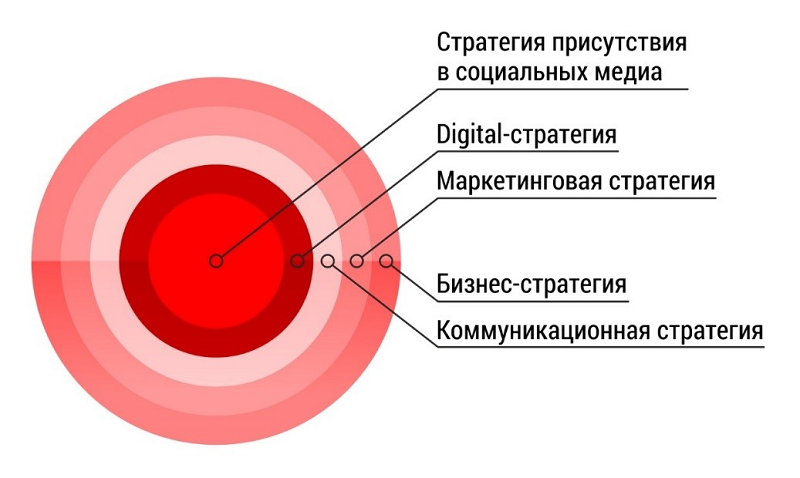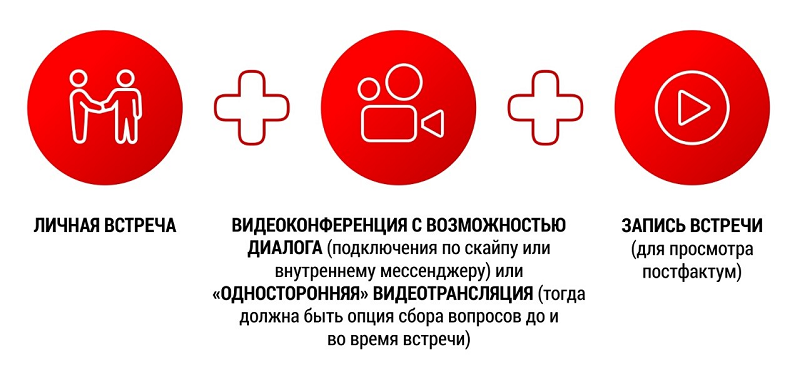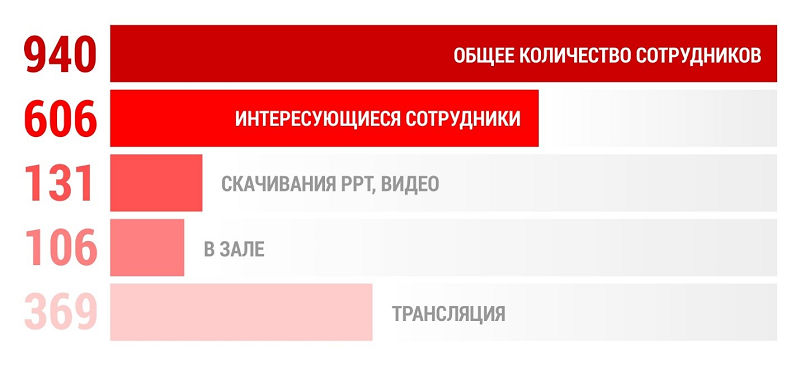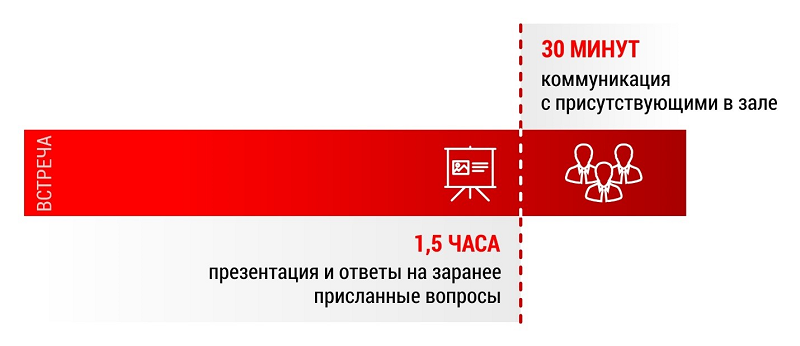900 IT specialists and 2 top managers: why should employees meet with management
Management and employee meetings at ICL Services are called Strategy Update. They have been held since 2011, when we were still about 350 people. By the way, now almost 1000. At the meetings, as the name suggests, various strategic issues are discussed. At the end of last year, we “knocked out” the statistics of “attendance” of meetings and decided to update the format. They added dialogue, planned a focus group, and at the same time they formulated why such meetings are needed at all.
Obviously: management meetings with employees are useful and interesting. And definitely needed. And regardless of the size of the company.

')
The availability of leadership is a condition of employee involvement. You can come to work for years and just carry out the plan, but ignore the development objectives. The employee involved perceives the company as his own and tries to do the job as best as possible. One of the effective ways to increase employee involvement is through the quantity / quality of his communication with management. For some, this item is generally the key.
What tasks can be solved with the help of such meetings?
1. Strategy vs. employee
Strategy is one of the key interests of management. She represents where the company is heading. And she often thinks that any formalization of her vision is not important enough. A typical employee at this time is interested in the context of his work and is worried about the future. If not in terms of strategy, then with their sharp "kitchen" issues.

There is an opinion that knowledge of strategy has no practical meaning for an employee of a working specialty. In fact, one cannot state unequivocally, because the motivating (= involving) factors depend more on the personality of the specialist, and not on the specifics of his activity. In addition, issues such as financial forecasts and plans are relevant to each of us.
If we set ourselves the task of communicating a strategy, it is necessary:
For example, these could be slides describing the progress of development on the main focuses enshrined in the strategy. In our company, these are finance (financial goals and achievements), processes (organization of effective activities), clients and personnel.
If the strategy is not fully formalized, then such meetings are simply created in order to deal with its details. Then the staff will be involved much more than if you inform them about the movement on the already prepared strategy. But this is true for small companies of the so-called "family" type.
2. "Inferiority complex"

Typically, this problem occurs in two types of companies:
With branches, the situation is even clearer. “What are they in there in the head”, and similar comments are not uncommon. Regular communication of management with the employees of the branches helps to keep the company complete, identify important topics, motivate employees for development. It can occur simultaneously with all branches (on video conferencing) or as part of special trips.
A few years ago, I worked in a small IT company (about 35 employees). Each weekly update, to which only the branch manager was connected (and this connection did not become regular right away), began with the phrase: “Well, something you are doing there, but we don’t know anything here.” Very often, this phrase sounded as an explanation of business failures.
3. To talk
Dialogue meetings are especially relevant when there is a change in business, and it is necessary for the whole company (team) to discuss risks, opportunities, options. Of course, the company must be sufficiently democratic for this.

In some cases, management is sufficient to present theses and options for development, inviting employees to speak freely and vote. Yes, it can be limited to electronic voting. But live communication with the management always gives “added value”. For those employees who are focused on supporting business, it will be enough to broadcast or view the record. Those who are not indifferent to the future of the company will gladly take part in the dialogue and share their views (and will be upset if they are deprived of this opportunity).
4. Really “burning” problem
Meetings caused by "burning" occasions are irregular. As a rule, in a company (or in an economic and social environment) something out of the ordinary happens, some kind of critical incident that requires the special attention of everyone working in the company.
For example, it may be a leak of confidential information that has affected the relationship with one of the key customers. At the meeting in this case, you can talk about the scale of the damage, as well as the algorithm of actions with respect to information security.
Or another example: after several months of business failure, it becomes obvious that the main reason for leaving the customers is a violation of the terms of service provision, and in working mode it is impossible to change this trend. In such cases, it is most effective to gather around the table at the whole company and discuss the situation. Moreover, the dialogue must begin with a clear presentation of the leadership on the relationship of contracts, project deadlines, financial stability of the company and each employee in particular.
Any employee, regardless of work schedule and level of need for a meeting, should be able to take part in it. Therefore, the ideal option for meetings of management and employees is the combination of several formats:

Our company has 5 geographically distributed offices, with the majority of employees working in Kazan, and they can take part in a personal meeting. However, the current leading format is translation.

Please note: the total number of employees who have shown interest in meeting with management is about 60%. And this can already ensure victory in the elections :-) Of course, given the interests of the electorate.
The specifics of the company will be important only in the preparation of the meeting plan and information materials. The very same approach will remain universal. We will arrange a meeting with management in 4 stages. And stage number 3 is a “novelty”, which we plan to release in preparation for the next meeting.
Performance criteria are determined at the stage of problem statement. The task should be formulated by management based on the expert assessment of the corporate climate by HR. In our case, paragraphs 1 and 2 are always relevant, and from time to time - paragraph 3.
In any case, the very fact that the management is open and ready to communicate with employees gives a solid “boost” to loyalty, involvement and overall corporate happiness. Do you agree?
If your management (or you as a manager) has not yet introduced the practice of regular meetings - try it, you and your employees will definitely like it.
Some theory
Obviously: management meetings with employees are useful and interesting. And definitely needed. And regardless of the size of the company.

')
The availability of leadership is a condition of employee involvement. You can come to work for years and just carry out the plan, but ignore the development objectives. The employee involved perceives the company as his own and tries to do the job as best as possible. One of the effective ways to increase employee involvement is through the quantity / quality of his communication with management. For some, this item is generally the key.
What tasks can be solved with the help of such meetings?
1. Strategy vs. employee
Strategy is one of the key interests of management. She represents where the company is heading. And she often thinks that any formalization of her vision is not important enough. A typical employee at this time is interested in the context of his work and is worried about the future. If not in terms of strategy, then with their sharp "kitchen" issues.

There is an opinion that knowledge of strategy has no practical meaning for an employee of a working specialty. In fact, one cannot state unequivocally, because the motivating (= involving) factors depend more on the personality of the specialist, and not on the specifics of his activity. In addition, issues such as financial forecasts and plans are relevant to each of us.
If we set ourselves the task of communicating a strategy, it is necessary:
- meet regularly with management;
- structure the information presented;
- constantly use this structure in the preparation of information materials.
For example, these could be slides describing the progress of development on the main focuses enshrined in the strategy. In our company, these are finance (financial goals and achievements), processes (organization of effective activities), clients and personnel.
If the strategy is not fully formalized, then such meetings are simply created in order to deal with its details. Then the staff will be involved much more than if you inform them about the movement on the already prepared strategy. But this is true for small companies of the so-called "family" type.
2. "Inferiority complex"

Typically, this problem occurs in two types of companies:
- with geographically distributed offices;
- with a large difference between professional groups (for example, office workers and field workers, as in most manufacturing enterprises). Even in the IT field there are “field” engineers who work with “iron” and, for the most part, in the customer's territory. They do not enter the portal, do not read news, rarely see bulletin boards.
With branches, the situation is even clearer. “What are they in there in the head”, and similar comments are not uncommon. Regular communication of management with the employees of the branches helps to keep the company complete, identify important topics, motivate employees for development. It can occur simultaneously with all branches (on video conferencing) or as part of special trips.
A few years ago, I worked in a small IT company (about 35 employees). Each weekly update, to which only the branch manager was connected (and this connection did not become regular right away), began with the phrase: “Well, something you are doing there, but we don’t know anything here.” Very often, this phrase sounded as an explanation of business failures.
3. To talk
Dialogue meetings are especially relevant when there is a change in business, and it is necessary for the whole company (team) to discuss risks, opportunities, options. Of course, the company must be sufficiently democratic for this.

In some cases, management is sufficient to present theses and options for development, inviting employees to speak freely and vote. Yes, it can be limited to electronic voting. But live communication with the management always gives “added value”. For those employees who are focused on supporting business, it will be enough to broadcast or view the record. Those who are not indifferent to the future of the company will gladly take part in the dialogue and share their views (and will be upset if they are deprived of this opportunity).
4. Really “burning” problem
Meetings caused by "burning" occasions are irregular. As a rule, in a company (or in an economic and social environment) something out of the ordinary happens, some kind of critical incident that requires the special attention of everyone working in the company.
For example, it may be a leak of confidential information that has affected the relationship with one of the key customers. At the meeting in this case, you can talk about the scale of the damage, as well as the algorithm of actions with respect to information security.
Or another example: after several months of business failure, it becomes obvious that the main reason for leaving the customers is a violation of the terms of service provision, and in working mode it is impossible to change this trend. In such cases, it is most effective to gather around the table at the whole company and discuss the situation. Moreover, the dialogue must begin with a clear presentation of the leadership on the relationship of contracts, project deadlines, financial stability of the company and each employee in particular.
Meeting Formats
Any employee, regardless of work schedule and level of need for a meeting, should be able to take part in it. Therefore, the ideal option for meetings of management and employees is the combination of several formats:

Our company has 5 geographically distributed offices, with the majority of employees working in Kazan, and they can take part in a personal meeting. However, the current leading format is translation.

Please note: the total number of employees who have shown interest in meeting with management is about 60%. And this can already ensure victory in the elections :-) Of course, given the interests of the electorate.
Behind the scenes
The specifics of the company will be important only in the preparation of the meeting plan and information materials. The very same approach will remain universal. We will arrange a meeting with management in 4 stages. And stage number 3 is a “novelty”, which we plan to release in preparation for the next meeting.
- Preparation begins one month before the approximate date of the event:
- coordination of the management calendar and the main business events of the company;
- analysis of the availability of venues (in the company, remove an external conference room, etc.).
- In two weeks a draft of the presentation is being prepared, which the management will show from the screen and comment. Internal communications specialists take an active part in the training.
- A weekly beta presentation is scheduled. It meets top management and invitees: heads of departments, key executives.
Conducting such "expert" meetings is always mutually beneficial cooperation.
Guide:- gets useful feedback on the current business situation from below;
- "Tests" the general availability of the transfer of information about changes;
Invited group:- asks questions that they need for better orientation in the business context and full answers to questions of subordinates;
- gets the opportunity to influence the announced decisions and the way they communicate throughout the company.
- The meeting itself , basically, lasts 2 hours.

A good addition to such working meetings is to hold any award ceremony: congratulations and a buffet will set up those who come in a positive way.
Efficiency mark
Performance criteria are determined at the stage of problem statement. The task should be formulated by management based on the expert assessment of the corporate climate by HR. In our case, paragraphs 1 and 2 are always relevant, and from time to time - paragraph 3.
- We want as many employees as possible to hear about our progress towards achieving strategic goals? Then it is enough to count the number of people who showed interest in the event (statistics on the use of any of the participation formats).
- Are you ready for dialogue, and is feedback especially valuable to us at this moment? It makes sense to count active participants and stimulate them: how many people asked the question, how many left a comment, etc.
- When you meet, in order to discuss a particular problem and ways to solve it , you should follow the “fate” of the problem for some time after the meeting.
In any case, the very fact that the management is open and ready to communicate with employees gives a solid “boost” to loyalty, involvement and overall corporate happiness. Do you agree?
If your management (or you as a manager) has not yet introduced the practice of regular meetings - try it, you and your employees will definitely like it.
Source: https://habr.com/ru/post/299232/
All Articles